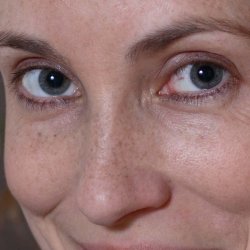Hey, let's have a Nikon user jump in here - all heck will break loose! (BTW if you're too impatient to read this whole post, at least read the third paragraph below)
dSLRs in general - including Nikons - tend to be softer coming out of camera. If you read the review sites, like dpreview, you'll likely see that Nikon dSLR images are even softer than Canon's by default - they bump up the Nikon's sharpness when they do those "compared to" shots (I know that's opposite of what a couple people said here, but go look for yourself - check out the D40x review, at the bottom of the
comparison images vs. the XTi).
But, in any case, I don't think you'll be happy switching - I see Nikon users occasionally saying pretty much the opposite of you, and asking "should I switch to Canon"? Neither brand has a lock on sharpness. When a person has problems with sharpness, it's almost always technique (and I'm speaking from experience! hehe). I know that sounds silly given that you've shot for so long, but especially with lighter digital cameras I think it's easier to introduce a small amount of camera movement. Plus there are gotchas with digital that weren't even present with film.
With that spider lure photo - at least some of the blurriness looks like it's due to the shallow macro depth of field (and the fringing on the other photo probably isn't in-camera sharpening per se, although the in-camera sharpening is exacerbating the CA problems the tiny lens + tiny filter have). You do get much greater apparent depth of field with the tiny sensor on the point-and-shoot. More importantly: that spider photo was shot at f/20 - physics is your enemy here because
diffraction is definitely killing your detail (something you didn't have to worry about with film). Try it at f/13 instead - that's probably the
smallest you can go on your sensor w/o worrying about diffraction.
Are you seeing sharpness issues with non-macro photos? The first thing to do is try shooting something similar using a tripod and remote release (if you don't have a remote release, set the shutter to delay a couple seconds after you depress the button).
But back to diffraction - if you need to shoot at f/20, you probably should consider a full-frame camera. The diffraction limit is related to the diameter of each individual photosite. Larger photosites mean you can shoot with smaller apertures. But the larger sensor will somewhat shorten your depth of field for a given aperture, so there's still a tradeoff.
P.S. I don't buy into the "primes are always sharper" argument. They're certainly sharper than consumer zooms; but Nikon has some pro zooms that match its excellent primes (and I'm sure Canon does as well).








